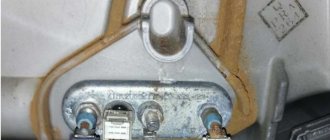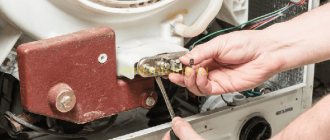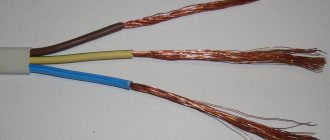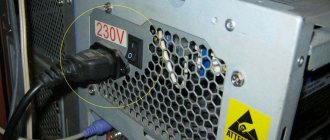Modern washing machines are equipped with high-quality heating elements, which allows for multiple washing modes with different temperatures. But heating elements often fail; at the first sign of a heating element failure, it is important to promptly seek qualified help. We offer you high-quality repair of the heating element control system. We work with machines of different brands, from Russian models to modern devices from Indesit, Lg, etc.
What is heating element in a washing machine?
Tubular electric heater
(
Heating element
) is considered one of the most important elements of washing machines, Veko, Whirpool and other brands. It is a metal tube with a heating coil located inside. The voids between the spiral and the tube are filled with a heat-conducting dielectric. The spiral has a high resistance, due to which, when heated, it heats the outer shell of the heating element, warming up the space around it.
Each machine model (Zanussi, Vyatka, Candy, Electrolux, etc.) uses its own version of the heating element. The heating element can vary not only in shape and size, but also in the type of material. The most difficult operation is considered to be replacing a ceramic heating element.
, because when working with such a part, extreme caution and dexterity are required.
Why do you need a heating element in a washing machine?
The main purpose of the heating element is to heat water for washing in a machine, etc. If voltage is not supplied to the heating element (due to a damaged cable or a broken power connector), the heating process will not be carried out. When the heating element relay is faulty, the mechanism is subject to overload, which is why it may soon break. A leak may also occur in the heating element area, then a comprehensive inspection of the machine should be carried out. Based on this, it follows that the owner must monitor the serviceability of all parts of the washing machine, because the failure of one element will entail the breakdown of other spare parts.
Signs of a broken washing machine heating element
You can determine the malfunction of the heating element on a Bosch washing machine by the following signs:
- The temperature level fluctuates
- usually the cause is a malfunction of the heating element sensor. This can lead to failure of the washing modes and general breakdown of the device control system; - the heating element has stopped heating
- visually this is manifested in the fact that on standard modes things are washed worse or traces of undissolved powder remain on the fabric; - The heating element heats the water constantly
- when the heating element relay does not turn on, this can cause damage to light and delicate tissues. By setting the “delicate wash” mode, instead of the preferred 40 degrees, the water will heat up to the maximum level, which is detrimental to silk, guipure, etc. It is quite possible that you will not have to change the part; the heating element heating relay often gets stuck, it will only need to be adjusted; - The heating element is noisy
- the process of heating water in washing machines is not accompanied by extraneous sounds. If noise is heard during heating, you should check the serviceability of the heating element relay; - The heating element is leaking
- the presence of water from the bottom of the machine during operation will warn the owner that there may be malfunctions of the heating element of the device.
Any of these signs may indicate that the heating element has failed.
Only an experienced specialist will help correct the situation by repairing the part or completely replacing it.
How to check the serviceability of the heating element
To determine possible breakdowns of the heating element, you need to find it inside the washing machine. On models Aeg, Ardo, Ariston, heating elements are most often installed at the rear; you can find them by removing the housing cover.
The heating element is the element of the washing machine responsible for heating the water during the washing process. It is located at the bottom of the tank and fails quite often. Even a high-quality Bosch machine may need to replace the heating element, let alone such budget brands as LG, Samsung or Atlant. In this case, to replace the heater, you can call a specialist or decide to remove the old heating element with your own hands. To do this, you must first determine where the heater is located and then remove it.
How to get to the heater
The first difficulty facing washing machine owners may be access to the heater. The thing is that in some machines it can be accessed through the back of the case, and in others through the front panel. To easily find out where exactly the part we are looking for is located, carefully inspect the machine.
Take a look first at the back surface of its body - if the part that can be removed is quite large, then most likely you can get to the heating element from the back of the machine. If you find that only a small area can be removed from the back, then most likely the heater is located in the front. If in doubt, first unscrew the back cover, because this is much easier to do than dismantling the front panel.
Note that the location of the heater at the rear is typical for machines of such brands as Zanussi, Candy, Hotpoint Ariston, Indesit, Ardo and Electrolux. But manufacturers Bosch and Samsung most often place heating elements at the front. To access the heater on top-loading models, one of the side walls must be removed.
Determining the location of the heating element
Manufacturers of washing machines can place heating elements in different places - both in the front and in the back. As a rule, in Atlant, Zanussi, Whirpool, Electrolux, Ariston, Indesit and Candy washing machines the heater can be located in the rear, but Bosch, LG and Samsung more often place this element in the front. For automatic machines with vertical loading, access to the heating element can be through the side wall. The easiest way to find out where the heating element is located in a particular model is by studying the operating instructions or making a request on the Internet. Very often, a detailed video is posted online on how to change the heating element in a washing machine of a specific model.
Another option is a visual inspection of the back of the washing machine, because to increase maintainability, the designers have provided fairly easy access to the heating element:
- Ø almost the entire rear area falls on the removable part - there is a high probability that the heating element is mounted at the back
- Ø removable part of a small area - in this case you will have to disassemble the front panel, this is a little more complicated. After all, you will have to remove the top cover, dismantle the powder (detergent) tray, partially disassemble the laundry hatch, and only then remove the front panel itself.
In principle, you can immediately remove the back cover (it’s simple, you only need to unscrew a few screws/bolts) to make sure which side the heating element is on.
See also –
Why doesn’t the washing machine heat the water?
How to remove the heater
Before removing the heating element, it is important to drain the water from the machine into a previously prepared container, and also make sure that the device is disconnected from the network.
- Unscrew the required cover of the machine and find the heater.
- Disconnect the wires that go to the heating element.
- Unscrew the nut that is located in the middle, and then drive the pin that was connected to the nut inside. To do this, press it firmly or lightly tap it with a hammer.
- Having picked up the heater (use a knife or screwdriver for this), carefully remove the heating element from the tank.
- Check the functionality of the part.
You can clearly see this whole process in the video below.
Installation of heating elements
Insert the repaired or new heater into the hole and make sure that the part is in the same position as it was before removal. You want to get a tight fit. Next, holding the heating element with your hand, carefully tighten the nut. Finally, you need to return the wires to their place. Now all that remains is to turn on the test wash by selecting a program that heats the water to +600C. If the water gets hot, you can secure the removed wall and return the washing machine to its place.
A washing machine breakdown is an important problem for the whole family. Often the cause of machine failure is a breakdown of the heating element. You can carry out the replacement at home, following clear instructions and algorithm of actions.
In a Samsung washing machine, the heating element is usually located on the flange, where the fuse is often also located. For example, this arrangement is in the WF8590NMW8 and WF8590NMW9 washing machines.
Installation Rules
When installing a new heating element, the following rules must be observed:
- Disassembly should be carried out using rubber gloves and only after disconnecting the machine from the network;
- before changing the part, it is necessary to check the new heater for external defects and operating resistance (the nominal parameter is indicated on the packaging or in the description);
- after removing the damaged element, you need to clean the hole (groove) from small debris, dirt, metal particles and scale, which can impair the performance of the new heater;
- Before installation, the seal must be lubricated with machine oil or WD-40;
- You need to carefully disconnect the front wall and the contacts of the heating element, because broken wires complicate diagnostics and increase the volume of repair work;
- You need to pull the contacts of the tubular element slowly, without jerking, because the legs may break off due to an increase in the thickness of the part due to the layer of carbonates.
Before disconnecting the contacts to check and replace the part, it is recommended to photograph or record the position of the wires in writing. Poor electrical contact with high power heating elements can lead to burning of the wires, so during installation you need to firmly connect all the elements of the circuit.
What causes the breakdown of the Ten in a Samsung washing machine?
The source of failure of the ceramic heating element may be a malfunction in the water heating system. On a Samsung Diamond washing machine, error h1 is displayed and the washing process stops. There may be three reasons for this:
- The Diamond washing machine has problems with the control module.
- The temperature sensor has failed.
- The heating element on the Samsung Diamond washing machine needs to be replaced.
A common cause of heater failure in a washing machine, especially in Samsung WF8590NMW8 and WF8590NMW9 washing machines, is too hard water, which causes scale to appear.
Causes of malfunction
A cold wash indicates a malfunction of the heating element. The machine does not respond to the user’s choice of high temperature mode and the water does not heat up. In Samsung Diamond models, error message H1 appears on the display, and the wash will end prematurely.
The reason for this behavior of the machine:
- Control unit malfunction;
- Temperature sensor malfunction;
- Burnt heating element.
The cause of failure of the heating element is most often the use of too hard water. As a result of washing in hard water, a layer of scale begins to form on the heating element, which prevents its normal heating. As a result, the heater overheats and eventually burns out.
How to replace the heating element in a Samsung washing machine?
Typically, the process of replacing the heating element should be handled by a specialist. But, if you want to start this process yourself, then you need to strictly follow the algorithm of actions:
- You need to empty the tank of water and disconnect the machine from the power supply.
- Remove the front cover so that the entrance to the heating element is accessible.
- Next, disconnect all existing wires that lead to the heating element, but carefully monitor the safety of these wires.
- After loosening the heating element, carefully pull the heating element towards you.
- Begin the process of cleaning the heating element from dirt, and most importantly, from scale.
- Now you should install a new heating element and, if necessary, a new drain hose.
What should I do to prevent scale from collecting on a ceramic heating element?
There are only two ways:
- Using special powders that will not create scale on the appliances of your washing machine.
- Periodic use of special chemical compounds that destroy scale.
Replacing the Ten in a Samsung washing machine.
If you treat your washing machine carelessly, then you will eventually face the problem of contamination and breakdown of the heating element. A new one will cost you from 600 to 1,500 rubles, depending on the washing machine. If you yourself are not able to replace the heating element, then you will also have to spend money on the work of a specialist. And if you took all your strength into your fist, and still decided to replace the heating element in the washing machine yourself, then you will have to go through the following stages in the work process, which you can also watch in the video:
- After you have removed the old heating element from the washing machine, you need to insert a new one in the same position. This is important - no displacement should occur. For best results, look at the photo.
- Carefully screw the nut onto the stud. Select a suitable key and tighten the heating element with it, but not too much.
- You need to carefully connect all previously disconnected wires to the new installed element.
- Many experts advise “seating” the new element on the sealant, because this will prevent unwanted leaks.
- Make sure all wires are connected correctly and close the cover.
- Set the washing machine to a low temperature wash cycle, no more than 50 degrees. If the machine works well, then there is no problem.
As you can see, replacing the heating element in a washing machine is not so difficult. You just have to adhere to the basic rules in operating and installing a new device.
Basically, the breakdown of the heating element does not even depend on the quality of your device, but on your attitude towards the washing machine as a whole. Use special anti-scale chemicals or periodically clean the internal appliances of the washing machine from scale and dirt. Be careful and attentive to your washing machine, because it must be handled with care in order to avoid damage.
If you notice a deterioration in the quality of washing in an automatic washing machine, you need to check whether the water is heated during the specified program. The situation when the water remains cold indicates a malfunction of the tubular heating element. This typical problem can be solved by replacing the heating element in the washing machine, which, if desired, can be done with your own hands.
In modern automatic washing machines, heating elements are located at the bottom of the tank. Some manufacturers, including Bosch and Samsung, place them in the front, while others, including LG and Atlant, mount heating elements in the back.
Visually, the location of the heating element in front-loading machines is easy to determine by the size of the back cover: if it is large, then most likely the water heater is located behind it. If the model is equipped with a plinth panel, then the required part should be looked for behind this door. In units with vertical loading, it is most convenient to carry out repairs through the side wall.
Before dismantling a failed device, you should disconnect the equipment from the power supply and drain the remaining water in the system. After this, you can unscrew the screws holding the back cover and remove it. Do the same with the side wall and base panel.
Before removing the heating element from the socket, it is necessary to disconnect all wires from it
To dismantle the heating device, it is necessary to loosen the nut on the central screw (as a rule, no more than six turns are enough) and push through the retaining screw. After this, the water heater is removed from the socket with little effort using two flat-head screwdrivers. In machines with plastic tanks, the process of removing the heating element goes without problems; with metal parts you will have to tinker a little longer. It is important to dismantle it carefully and without excessive pressure, so as not to damage the washing machine tank.
How to get a heating element for a Samsung washing machine
A feature of these washing units is that the heating element is located directly on one of the outer walls of the tank and getting to it is not always an easy task. But nevertheless, this is not an impossible action. It may seem so only at first glance. Therefore, there is no need to contact a specialist and replace the heating element for a Samsung washing machine at an additional cost. You can do this yourself. Before changing the heating element, you need to disassemble the Samsung washing machine. Here is the order of the work:
- First, we drain the water remaining in the tank; to do this, you need to unscrew the hose with the filter, and the water will flow out;
- then you need to disconnect the front panel of the washing machine by unscrewing the bolts that hold it;
- remove the powder box, unscrew all the remaining fasteners;
- the unscrewed control panel can be moved to the side so that it does not interfere;
- Now you need to carefully remove the sealing rubber around the hatch. This should be done very carefully so as not to damage the cuffs, because it is not easy to replace;
- Use a flat screwdriver to pry up the plastic panel and expose the body of the machine;
- Now the control panel can be unscrewed and pulled out, having first disconnected the harnesses and contacts;
- The front panel can now be easily removed and we can see the inside of the washing machine.
After the front cover is removed, you can see the heating element itself on the Samsung washing machine. In this position, you can check it without removing it. Initially, you need to measure the resistance with a multimeter. The process is simple and does not take much time, provided you have certain knowledge. Apply the ends of the multimeter to the contacts of the heating element and turn on the device. The readings of the device should range from 25 to 30 ohms. In this case, the electric heating element is working properly.
If it turns out that the heating element is still faulty, it must be disconnected and replaced with a new, previously purchased one. Here is the replacement order:
- unscrew the nuts from the mounting bolts;
- pull the contacts from side to side;
- With a hammer, you can gently hit the studs from which the nuts have just been removed a couple of times;
- carefully pull out the faulty element.
After removing the faulty heating element, you need to check the resistance of the new part again, and if it is working, then you can put it in place.
First, drip some machine oil onto the rubber band. The installation process is the reverse of dismantling. See also -
Samsung washing machine displays error 5E: solve the problem yourself
Nuances of choosing a new heating element
Ideally, you should choose a new heating element while having a failed heating element with you. If the purchase is made through online stores, you will have to select a spare part with measuring instruments in hand.
Pay attention to the size and shape of the water heater, which can be straight or curved. If a curved water heater is used in the machine, then the length and angle of the bend, as well as its location, should not be overlooked.
The new heater must have a similar shape and exactly the same size
It is imperative to take into account the power indicators of the heater; if there are no heating elements with exactly the same power, you can purchase a device with deviations of no more than 150 W in one direction or another. However, this will affect the rate of heating of the water - it will heat up either faster or slower. It is also worth paying attention to the presence of a connector for installing a temperature sensor and the type of seal, which can be with or without a side.
How to replace
To replace a non-functioning heating element with a new one, you will need:
- Disassemble the washing machine, taking into account its design features.
- Disconnect the wiring and check its condition using a tester.
- Carry out dismantling.
- Install a new, working heating element.
- Reassemble the washing machine to its original state and check its functionality.
Features of design and disassembly of various models
Depending on the manufacturer of the washing machine you use in your home, disassembling it may have some nuances that need to be taken into account. Among the common models often purchased in stores are the following brands:
- Samsung;
- Ariston;
- LG;
- BOSH;
- Indesit.
Samsung
Washing machines from Samsung are considered one of the easiest to disassemble. To work with them you need to know the following things:
- The heating element that needs to be replaced is located under the front cover, at the bottom of the water tank. Access to it is not blocked by anything, and getting to it is no problem.
- The compartment for loading washing powder is attached to the structure using 2 screws and, if necessary, can be easily dismantled.
Indesit
Equipment manufactured by Indesit is also not difficult to disassemble. Necessary:
- minimal set of tools;
- carefully disconnect the board with wires when dismantling the heating element;
- The heater itself is located very conveniently; to dismantle it, just unscrew the back cover of the machine.
Ariston
Replacing a heater in Ariston does not present any problems for the owners. It is located extremely conveniently and practically. Problems arise when the bearings located inside the tank fail.
If they or the seals are damaged, you will have to buy a new entire assembly.
LG
Household appliances from LG are not designed in the most convenient way and when disassembling them you will have to tinker a lot. Algorithm of actions:
- First, the nuts are unscrewed, with which the hatch cover is secured.
- Once the nuts are removed, remove the front panel.
- The next step is to unscrew the screw, which is used to hold the clamps holding the cuffs together.
- The heating element is located under the tank.
- To remove the tank, you must first twist the weighting material.
Note! If you are not confident in your abilities, take the machine to a service center. There she will undergo a comprehensive diagnosis under the supervision of experienced specialists.
Bosch
BOSH is easy to disassemble. To dismantle components that have failed during operation, no special tools or skills are required. According to experts, to completely disassemble the washing machine you only need to have:
- Phillips screwdriver;
- wrench.
See also
Rules for painting walls in an apartment with your own hands for beginners
Disconnecting wiring and checking with a tester
Before disconnecting the heating element from the machine, be sure to do the following:
- Disconnect the device from the network and turn off the water.
- Before disconnecting the wires leading to the heater, their location must be remembered or photographed.
- A tester test is carried out to determine the condition of the heater. If the tester shows several ohms, the device is working. When the tester determines large values, starting from 10 and above, the part can be safely thrown away.
Dismantling
The algorithm for dismantling may differ slightly depending on the manufacturer of the unit, but, in general, it looks like this:
- It is necessary to remove the nut that secures the heating element to the body.
- Using a rubber hammer, carefully tap the pin.
- We carefully remove the damaged element.
- We check it for functionality.
Installing a new element
To install a new element, follow these steps:
- install the heater and tighten the nut on the main screw;
- We connect the electrical wires to the places where they were before dismantling.
Reassembly and inspection
To perform reverse assembly, install the parts twisted from the machine in the reverse order. Once the assembly is complete, do the following:
- We run a test wash and carefully observe to see if any leaks have appeared anywhere.
- Let's check how the water heats up.
- If everything is in order, we put the machine in place.
How to properly install a heating element in a washing machine
The new heating element is placed in its designated place, and the device is positioned in the same way as the failed one. After making sure that the heating element is in the desired position, tighten the central nut without excessive force. Next, return the belt to its place and rotate the drum by hand to make sure that the installation is correct and there are no interferences.
If nothing interferes with the operation of the drum, wires and a grounding cable are connected to the heating device. After this, the protective cover is screwed on (not with all screws), and the washing machine is connected to the network and a washing program is set, which includes heating the water to at least 60 degrees. In this way, the functionality of the new heating element and machine is checked. If the trial cycle goes through without any problems, the back cover is thoroughly screwed to the body and the household appliances are installed in their original place.
Of course, replacing the heating element in a washing machine cannot be called a simple task. This process requires certain skills and compliance with safety precautions, otherwise you will have to replace not a single spare part, but an entire expensive unit. In order not to take risks, it is better to immediately entrust this difficult work to specialists who will quickly determine the extent of the damage and find the best way to fix it.
The service provider provides a service for replacing heating elements in washing machines with horizontal and vertical loading in Moscow and the Moscow region. Within 24 hours after calling the technician, our specialist will come to your home with all the necessary spare parts and tools and replace the heating element of the washing machine quickly and with a guarantee! a 6-month warranty on the new heating element and the work performed to replace it.
.
Let's get to the details
If we are talking about replacing the heating element in an Indesit or LG washing machine, then there is nothing difficult in this work, because in machines of these brands the heating element is located at the back. You just need to remove the back wall, remove the drive belt, and lo and behold, the heating element is already within reach. With a Samsung washing machine, not everything is so simple, because its heating element is installed in the front wall of the tank, and the front wall of any washing machine is more difficult to remove than the back.
Important! There are also advantages to the front location of the heating element of the Samsung washing machine, because in order to remove the front wall it is not at all necessary to completely pull out the washing machine and disconnect it from all communications.
However, this small difficulty should not prompt you to contact specialists who will charge you extra money to replace the heating element in your Samsung washing machine. Replace it yourself, especially since such repairs are considered simple. So, how to remove the front wall of a Samsung washing machine?
- We unscrew the garbage filter of the Samsung washing machine to drain the remaining water in the tank, and at the same time take out the powder cuvette.
- Unscrew the screws that hold the top cover of the washer. They are located on the back of the upper right and left corners of the Samsung washing machine.
- We unscrew 2 fasteners that are located under the cuvette of the Samsung washing machine and one that is located on the right side of the control panel.
- We move the control panel, but there is no need to remove it yet.
- Using a flat-head screwdriver, we attach a thin plastic clamp encircling the hatch cuff and remove it, simultaneously tucking the cuff itself deeper into the hatch.
- Use a flat-head screwdriver to pry up and remove the bottom narrow panel of the Samsung washing machine, exposing the steel frame of the case.
- Along the bottom of the front wall of the washing machine there are 4 screws that were not visible under the decorative panel, but now they can be freely unscrewed, which is what we are doing.
- We lift the control panel that we unscrewed earlier and place it on top of the washing machine body, under the panel we find 3 more screws that hold the front wall, we need to unscrew them.
Be careful! When lifting the control panel, do not accidentally tear off the electrical wiring. They are very thin in places and are held on by snot; if you tear them off, you will add problems.
- The front wall of the Samsung washing machine is now supported by only two hooks. We take it by the lower corners, and carefully lift it up and remove it. There is no need to pull the wall too much towards you, because the wires from the hatch blocking device will follow it. You can not touch them at all, but turn the wall to the side, leaning it against the side of the washer body so that it does not interfere.
- The control panel will no longer interfere with anything. You can carefully lower it down so that it does not fall off the body of the washer when the heating element is replaced, so that again the wires do not accidentally come off.
Well, when the front wall of the Samsung washing machine is removed, we can see the contacts of the heating element right before our eyes. But there is no need to rush to replace the heating element. First, we will check everything, make sure that the unit is faulty, and only then we will make a final decision.
Functionality check
We will always have time to replace the heating element; first we will check everything. How to do it? Well, first of all, you need to prepare your multimeter. We set up the device to check resistance, setting the minimum value in Ohms. Now we remove all the wires from the heating element sensors. This must be done carefully so as not to inadvertently tear off anything.
Next, we install one probe of our measuring device on one contact of the heating element, and the second probe needs to be leaned against the second contact and see what resistance value appears on the multimeter display. If the number on the display is close to 28, for example 25, 27 or 30 Ohms, the heating element is working. Well, if the meter shows 0 or one, the heating element has burned out. You will have to buy or order a similar part and replace the heating element yourself.
By the way, the heating element is far from the most expensive part of a Samsung washing machine, but you need to be careful when purchasing, since the heating elements are also different for different models. They differ in power and modification, so in order not to make a mistake, carefully look at what is written on the old heating element. Or even take the old heating element with you to the store and show it to the seller of washing machine parts - it will be more reliable. The minimum price for a new part is currently about 6.5 dollars, and the maximum is about 30 dollars.
! The heating element power of a Samsung washing machine is mainly 1.85 or 1.9 kW.
How much does it cost to replace a heating element on a washing machine?
The cost of replacing the heater without taking into account the price of a new heating element is from 1,400 rubles
. The exact amount is calculated by the technician on site and depends on the brand and model of the washing machine. The table below shows the cost of replacing the heater by brand of washing machine. It includes:
- work on disassembling the washing machine and removing a faulty heating element;
- installing a new heating element and assembling the machine
Attention! The cost of the heating element itself (spare parts) is not included in this amount.
| Washing machine brand | Cost of replacement work* |
| Visit of the master | For free |
| Bosch washing machine | from 1700 rub. |
| Washing machine Indesit | from 1500 rub. |
| Samsung washing machine | from 1800 rub. |
| LG washing machine | from 1800 rub. |
| Ariston washing machine | from 1500 rub. |
| Washing machine Candy | from 1600 rub. |
| Electrolux washing machine | from 1700 rub. |
| Washing machine Zanussi | from 1800 rub. |
| Miele washing machine | from 2900 rub. |
| Whirlpool washing machine | from 2100 rub. |
| BEKO washing machine | from 1600 rub. |
| Washing machine Siemens | from 2300 rub. |
| Washing machine Ardo | from 1700 rub. |
| Washing machine AEG | from 1800 rub. |
| Brandt washing machine | from 1600 rub. |
| Washing machine Atlant | from 1400 rub. |
| Washing machine Gorenje | from 1900 rub. |
| Hotpoint Ariston washing machine | from 1900 rub. |
| Other brand | from 1400 rub. |
* The indicated price is FOR WORK ONLY
for replacing the heating element, the price of a new heater is not included
How to call a specialist
Simply and easily. You can call a specialist by phone from 8 to 22 without holidays and weekends:
7 (495) 215 – 14 – 41
7 (903) 722 – 17 – 03
or using the online form on the website (24/7).
When contacting the RemBytTech workshop, please inform:
- The brand and, preferably, model of the washing machine on which the heating element needs to be changed. For example, Bosch Maxx 5 or Samsung F813J. The exact model name can be found on the tag on the body of the washing machine. If you have already purchased a new part, indicate only the brand of the machine.
- Convenient day and time for the specialist to arrive.
- Your last name, first name, address where repairs need to be carried out, and telephone number.
On the day you set, the specialist will call you back to confirm the time of arrival.
Our advantages
- Free repair consultation
. There is a Question and Answer section on the website especially for your questions. Professional experts answer. Describe your problem in detail, and a specialist will respond within 48 hours. You can also leave a repair request: the technician will contact you by phone and advise you on possible breakdowns of your washing machine and the cost of fixing them. - Free visit and diagnostics
. If you agree to replace the heater by RemBytTech, a specialist visit and diagnostics of the machine are free. - Repair at home within 24 hours after calling the specialist
. Thanks to the territorial presence of specialists in all districts of Moscow and most cities of the Moscow region, our specialists serve orders in the shortest possible time - within 24 hours after the request. All work is carried out at the customer’s home; there is no need to take the equipment to the workshop. - Opening hours: 8 a.m. to 10 p.m. daily
. Our technicians visit clients’ homes from early morning until late evening, seven days a week and seven days a week. You can easily choose a repair time that is convenient for you. - 6 month warranty
. For work on replacing the heating element of a washing machine, a guarantee is issued for a period of 6 months (for work and for spare parts, if they were purchased from our specialist).
The procedure for replacing the heating element
The order is as follows:
- Disassembling the washing machine.
The heating element is located under the washing machine tank; disassembly is required to get to it. In the simplest case, if the heating element is removed from the back, the technician will simply need to unscrew the back wall of the washing machine, which is secured with several screws. This arrangement of the heating element is typical for most washing machines from manufacturers Indesit, Hotpoint-Ariston, Zanussi, LG, Candy, Ardo, Electrolux, etc. You will have to tinker more with disassembly if the heater is removed from the front. The technician will need to remove the top cover of the washing machine and disassemble the front panel. The front location of the heating element is most often found in washing machines of the Bosch and Samsung brands. - Disconnecting the supply wires and the continuity of the heating element.
Before replacing, the technician must check the heating element with a multimeter for an open circuit, short circuit, or breakdown to the housing. There have been cases when, according to all indirect signs, the heating element of the washing machine seemed to be faulty, but the reason turned out to be not in it. - Dismantling a faulty heating element.
To do this, the master unscrews the central nut that secures the heater without removing it from the stud, and with the help of light taps pushes the stud and nut inward to press out the rubber gasket-seal of the heating element. Then, by hand or using a flat-head screwdriver, the technician carefully pulls the heating element out of the tank. - Installing a new heater.
Perform in the reverse order of removal. The technician inserts the heater into the tank as far as it will go, checks that the heater is firmly seated in place and does not loosen, and then tightens the central nut. Then the wires are connected to the heater. - Checking the work.
The master starts a program with water heating and checks that after replacing the heating element there are no leaks and the element itself is working properly. - Assembling a washing machine.
Replacing the heating element
If, as a result of measuring the resistance, a malfunction of the heating element was identified, then it must be replaced with a heating element of the same power and size. Replacing the heating element in a Samsung washing machine is performed in the following sequence:
- After unscrewing the small nuts on the contacts of the heating element, you need to remove the wires connected to it, and also remove the terminals from the temperature sensor.
- Use pliers or a socket wrench to loosen the central nut, which then needs to be pressed with some elongated object.
- Using a slotted screwdriver, pry the heating element around the entire perimeter and carefully remove it from the tank.
- A new heating element is being installed.
Before installing a new heating element, it must also be checked with a multimeter. In order to simplify installation, as well as to ensure greater tightness, it is recommended to lubricate the rubber gasket of the heating element with engine oil. All operations are performed in the reverse order of removal. In this case, you should ensure the highest quality connection of the wires with the heating element. Some models may be equipped with a heating element, the power of which can reach 2 kW, so insufficient contact of the wires supplied to the part can lead to their burnout.
Signs that the heating element in the washing machine has burned out
Any malfunction in the washing machine is characterized by a number of symptoms. An experienced technician can use such indirect signs, without conducting an exact diagnosis, to determine which unit is most likely to fail. Tens of thousands of heating elements replaced by RemBytTech specialists allowed us to compile an accurate list of signs that may indirectly indicate a breakdown of the heating element.
- The washing machine does not heat the water.
This is exactly how it will manifest itself during washing, if the heating element is “burnt out” or, in professional language, “broken.” In this case, washing programs in cold water without heating can be performed normally. Modern models of washing machines, when the heater breaks down, as a rule, show a heating error “reaching” the moment the heating element is turned on. “Ancient” machines can wash endlessly while waiting for the water to heat up. - The washing machine knocks out the machine
immediately after starting the wash or after 8-12 minutes when the heating is turned on. This situation is typical for a short circuit of the coil inside the heater. - The washing machine trips the RCD
immediately after turning it on or while heating the water. This is how the heating element shorts to the housing (breakdown) or current leaks to the housing during heating due to poor insulation of the heating element.
Note!
That these symptoms only indirectly indicate a malfunction of the heating element.
For an accurate diagnosis, it is necessary to check (continuity) the heating element with a multimeter. Other possible malfunctions accompanied by the indicated symptoms are presented in the articles “What to do if the washing machine does not heat the water” and “9 reasons why the washing machine knocks out the machine .
Heating element device
In washing machines, a heating element is used as a heating element, which is presented in the form of a curved tube. Inside this part there is an incandescent coil, which is separated from the body of the tube by dielectric powder. The reasons for the failure of the heating element are considered to be:
- Long service life (after repeated heating and cooling, the spiral simply collapses);
- The appearance of scale on the tube. If the machine is connected to a centralized water supply, then after several acts of operation, scale remains on the tube, since the tap water is hard. The appearance of scale can be prevented by using water softeners.
In addition, scale reduces the efficiency of the heating element, the water heats up more slowly, and the energy consumption of the machine increases.











